New to the 2013 CVO stage are the Road King and
Breakout while the Ultra Classic Electra Glide and Road Glide Custom
return for encore performances. Auspicious is the 2013 model year for
Harley-Davidson as the company celebrates 110 years of motorcycle
manufacturing. To augment the occasion, Harley is offering three CVOs in
anniversary garb with 110th-anniversary badging and fuel tank
medallions, but the Breakout is way too cool to participate in any
organized merrymaking.
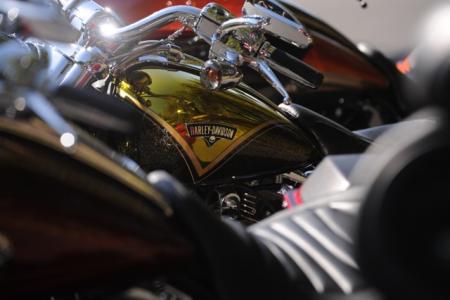 They’re
all special, but our personal favorite of the four 2013 CVO models is
the new Softail Breakout in its Hard Candy Gold Dust/Liquid Sun with
Pagan Gold Graphics color scheme.
|
Standard among all CVO models is the Screamin’ Eagle Twin Cam 110
engine (110B on the Breakout) and the new Assist & Slip Clutch Pack
said to reduce driveline loading during downshifts. The clutch lever has
been reshaped to optimize control while clutch action is reduced by 10
percent and clutch lever hold-in force is 17 percent lower.
Twenty-thirteen CVOs also come with cruise control, ABS and H-D’s Smart
Security System as standard equipment.
Extra benefits when purchasing a 2013 CVO come in the form of a CVO
embroidered indoor/outdoor storage cover and a one-year membership to
the H-D museum including all kinds of special CVO privileges and
discounts.
Let’s now get on to the specifics of each new 2013 CVO model.
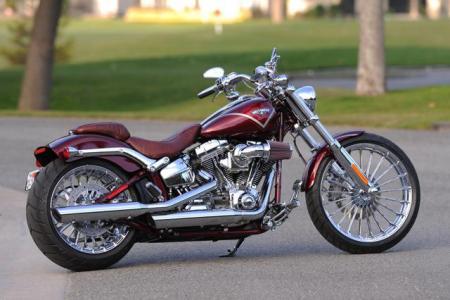 The Heavy Breather intake attached to the Screamin’ Eagle Twin Cam 110B engine emphasizes the Breakout’s virility.
|
2013 Harley-Davidson CVO BreakoutPrice: $26,499
Worldwide Production: 1,900 units
Performance: 112 ft. lbs. @ 3500rpm
Colors: • Black Diamond/Molten Silver with Crushed Slate Graphics
• Crimson Red Sunglo/Scarlet Lace with Hammered Sterling Graphics
• Hard Candy Gold Dust/Liquid Sun with Pagan Gold Graphics
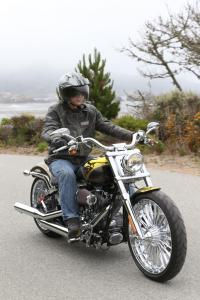
Best
power-to-weight ratio of any 2013 Harley, but cornering ability is
limited because of minimal ground clearance and suspension travel.
Polished chrome Turbine wheels rolling on a fat 240/40-18 rear tire
and equally wide 130/60-21 front with fenders chopped to the legal limit
to show off as much rubber as possible, the new Breakout strikes an
imposing profile without trying. Weighing 724 pounds wet and producing a
claimed 112 ft.-lb. of torque at 3500 rpm, the Breakout boasts the best
power-to-weight ratio of any 2013 Harley-Davidson model.
Powering the CVO Softail is a Screamin’ Eagle Twin Cam 110B engine
with a Heavy Breather intake. The Electronic Sequential Port
Fuel-Injected (ESPFI) motor is manipulated via Electronic Throttle
Control (ETC) and the power is delivered to the rear wheel by way of
hydraulic clutch operation, an Assist & Slip Clutch Pack, and a
6-speed Cruise Drive transmission.
Of the three paint schemes two feature hand-polished steel sections
on the fuel tank and fenders while the third incorporates hand-laid lace
stenciling. While the two hand-polished Breakouts sport black leather
seats, the Crimson Red model flaunts brown leather seats. The CVO
Breakout also boasts a polished and chromed single-rib cast aluminum oil
tank.
For a full review of the 2013 CVO Breakout click here.
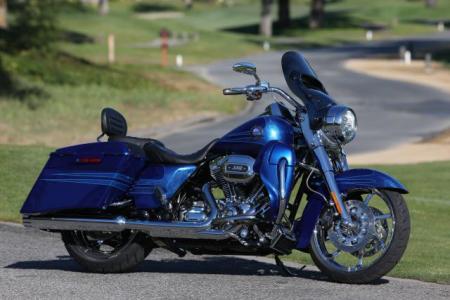 Absent since 2008, the Road King returns to the CVO lineup with an MSRP almost identical to its predecessor from five years ago.
|
2013 Harley-Davidson CVO Road King Price: $29,999/$30,999 anniversary model
Worldwide Production: 3,620 units including 900 anniversary models
Performance: 118 ft. lbs. @ 3750rpm
Colors: • Burgundy Blaze with Hot Fusion Graphics
• Crushed Sapphire with Cold Fusion Graphics
• 110th Anniversary Edition Diamond Dust/Obsidian with Palladium Graphics
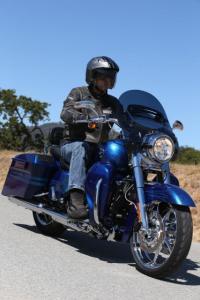
The
Wind Splitter windshield with adjustable venting works, but some may
not approve of its styling, and for that it’s detachable.
The Road King isn’t new to the CVO scene, having received the
customized treatment on four other occasions, but at $29,999 next year’s
CVO Road King is priced nearly the same as its last iteration in 2008,
but with 2013 model-year amenities. The new CVO Road King is the first
Road King to receive a factory-installed audio system with a 200-watt
amplifier. The system features handlebar controls for operating the
included 8GB iPod or your personal iPod/iPhone. Sound is pumped through
two 5.25-inch speakers mounted in the fairing lowers and two 5x7-inch
speakers located in the saddlebag lids. A handy carrying pouch in the
saddlebag keeps the iPod/iPhone safe and dry when riding.
The 2013 CVO Road King is distinctive by way of its vented Wind
Splitter windshield. The detachable windshield was developed in the
Wichita State University’s wind tunnel. Using computational fluid
dynamics, the H-D team was better able to determine the flow of air over
and around objects thus significantly reducing wind buffeting to the
rider. The vane within the vent is adjustable to match air flow to a
rider’s preference. Not a breakthrough technology, the vented windscreen
does, however, work as described while its swoopy design distinguishes
it from lesser aftermarket options.
Other 2013 refinements include a new, ergonomically designed,
1.25-inch, chromed handlebar and a solo touring seat (via a removable
passenger pillion) with a lower seat height. A low-profile console
includes both a speedometer and a tachometer, and features programmable
background colors. A new painting process features hand-finished
graphics created with textures and solvents in a multistep process
resulting in unique detailing on each motorcycle.
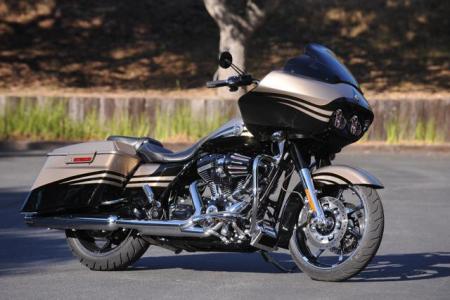 Back in black, the CVO Road Glide Custom returns for 2013 in its more-black-than-chrome guise.
|
2013 Harley-Davidson CVO Road Glide Custom Price: $32,999/$33,999 anniversary model
Worldwide Production: 3,150 units including 900 anniversary models
Performance: 122 ft. lbs. @ 3750rpm
Colors: • Atomic Orange/Galaxy Grey with Edge Graphics
• Roman Gold/Burnt Emerald with Edge Graphics
• 110th Anniversary Edition Diamond Dust/Obsidian with Palladium Graphics
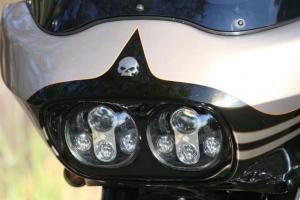
If light made noise, the dual LED Daymaker headlights illuminating the way for the CVO Road Glide Custom would be deafening.
While not exactly a Dark Custom, the blacked-out CVO Road Glide
Custom introduced last year returns for 2013 with one magnificently
bright trait — the Daymaker LED headlight. A first for any production
Harley, the LED headlamp, compared to a halogen bulb, increases low-beam
lighting distance (punch) by 30 feet (345 ft. vs 315 ft.), and the
spread of light by 55 feet (120 ft. vs 65 ft.). High-beam effectiveness
is even more impressive, increasing the headlight’s punch from 610 feet
to an amazing 740 feet (an increase of 130 feet.), and the spread from
110 feet to 120 feet.
Viewed side-by-side at night with last year’s halogen-equipped Road
Glide, the increased viewable field is obvious, and while the LED
low-beam and high-beam lights are 37 and 31 percent brighter,
respectively, power consumption is reduced by 50 percent.
Like the Road King, the 2013 CVO Road Glide gets the new 200-watt
amplifier to feed its six speakers: two 5x7-inch fairing-mounted
speakers, two 2-inch dash-mounted tweeters, and new for 2013, two
5x7-inch saddlebag lid speakers with bridged tweeters. Gone is last
year’s unsightly radio antenna, now hidden within the fairing. The
Harman/Kardon stereo features CD/AM/FM/WB and comes standard with an 8GP
iPod in the right saddlebag.
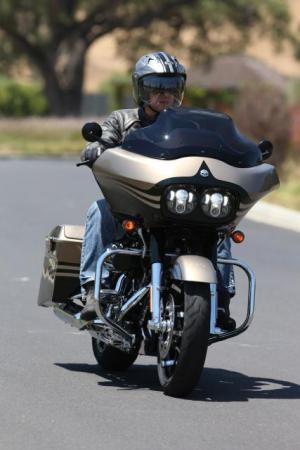 With
122 ft. lbs. of torque on tap at 3750 rpm, the Road Glide boasts the
highest performing CVO engine. Complemented with respectable ground
clearance, the Road Glide makes for a sporty handling bagger.
|
Also new on the 2013 Road Glide Custom is the 1.25-inch, internally
wired, black powder coated handlebars, a smoked Wind Splitter windscreen
with a ghosted H-D graphic, diamond pattern leather seats, as well as
hand controls, brake pedal, pegs, floorboards and heel shifter from the
new Sliptstream Collection.
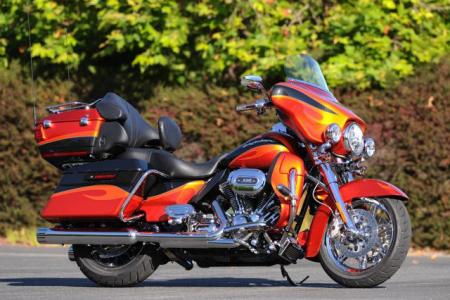 The
best bagger in the business is the CVO Ultra Classic Electra Glide. The
only way to one-up this machine is to throw down the extra thou for the
Anniversary Model.
|
2013 Harley-Davidson CVO Ultra Classic Electra Glide Price: $37,599/$38,599 anniversary model
Worldwide Production: 3,900 units including 1,100 anniversary models
Performance: 118 ft. lbs. @ 3750rpm
Colors: • Stardust Silver/Dark Slate/Titanium Dust with Thunderblade Graphics
• Tribal Orange/Dark Slate/Inferno Orange with Thunderblade Graphics
• Typhoon Maroon/Black Diamond/Burgundy Blaze with Thunderblade Graphics
• 110th Anniversary Edition Diamond Dust/Obsidian with Palladium Graphics
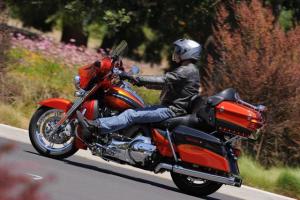
I could spend all day, every day in this position until financial ruin or death made me stop. Yep, the seat is that comfortable.
At $38,599 the 2013 CVO Ultra Classic Electra Glide Anniversary
Edition earns the honor of most expensive production Harley-Davidson,
but the standard model at $37,599 is only $350 more expensive than the
2012 model it’s replacing.
One of the most comfortable full-dress touring cruisers available
today, the Ultra Classic Electra Glide is also an impressive performer
in its own right. Having the pleasure to be aboard the CVO Ultra Classic
Electra Glide on a spirited ride through the coastal mountains North of
Monterey, California, during the CVO’s recent press introduction, I
later parked the bike with a newfound appreciation for its handling
mannerisms. Along a particularly bumpy stretch of asphalt, the FLHTCUSE
bottomed its suspension a couple times and scraped its floorboards now
and again, but it never once lost composure, which, for a bike weighing
927 pounds wet, is quite an accomplishment.
And all this backroad scratching is taking place with music streaming
from my iPhone safely secured in the saddlebag and blaring through the
Harman/Kardon stereo system with high-performance BOOM! speakers (four
5.25-inch speakers with 40W per channel) and bass booster ports. A high
fidelity, high performance experience on a luxo-touring motorcycle
representing 110 years of American perseverance.
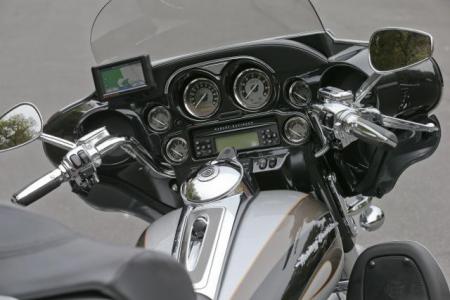 The cockpit is functional, efficient and aesthetically pleasing, and the sound system is without equal.
|
For 2013 the CVO Ultra Classic Electra Glide returns with only one
model-specific change, perforated leather inserts on the seats and
backrest, but it also enjoys the upgrades of the other CVO models
including the Assist & Slip Clutch Pack, Slipstream Collection of
grips, floorboards, pedals, pegs, etc., the indoor/outdoor CVO
embroidered cover and new paint schemes.

























 They’re
all special, but our personal favorite of the four 2013 CVO models is
the new Softail Breakout in its Hard Candy Gold Dust/Liquid Sun with
Pagan Gold Graphics color scheme.
They’re
all special, but our personal favorite of the four 2013 CVO models is
the new Softail Breakout in its Hard Candy Gold Dust/Liquid Sun with
Pagan Gold Graphics color scheme. The Heavy Breather intake attached to the Screamin’ Eagle Twin Cam 110B engine emphasizes the Breakout’s virility.
The Heavy Breather intake attached to the Screamin’ Eagle Twin Cam 110B engine emphasizes the Breakout’s virility. Absent since 2008, the Road King returns to the CVO lineup with an MSRP almost identical to its predecessor from five years ago.
Absent since 2008, the Road King returns to the CVO lineup with an MSRP almost identical to its predecessor from five years ago. The
Wind Splitter windshield with adjustable venting works, but some may
not approve of its styling, and for that it’s detachable.
The
Wind Splitter windshield with adjustable venting works, but some may
not approve of its styling, and for that it’s detachable. Back in black, the CVO Road Glide Custom returns for 2013 in its more-black-than-chrome guise.
Back in black, the CVO Road Glide Custom returns for 2013 in its more-black-than-chrome guise. If light made noise, the dual LED Daymaker headlights illuminating the way for the CVO Road Glide Custom would be deafening.
If light made noise, the dual LED Daymaker headlights illuminating the way for the CVO Road Glide Custom would be deafening. With
122 ft. lbs. of torque on tap at 3750 rpm, the Road Glide boasts the
highest performing CVO engine. Complemented with respectable ground
clearance, the Road Glide makes for a sporty handling bagger.
With
122 ft. lbs. of torque on tap at 3750 rpm, the Road Glide boasts the
highest performing CVO engine. Complemented with respectable ground
clearance, the Road Glide makes for a sporty handling bagger. The
best bagger in the business is the CVO Ultra Classic Electra Glide. The
only way to one-up this machine is to throw down the extra thou for the
Anniversary Model.
The
best bagger in the business is the CVO Ultra Classic Electra Glide. The
only way to one-up this machine is to throw down the extra thou for the
Anniversary Model. I could spend all day, every day in this position until financial ruin or death made me stop. Yep, the seat is that comfortable.
I could spend all day, every day in this position until financial ruin or death made me stop. Yep, the seat is that comfortable. The cockpit is functional, efficient and aesthetically pleasing, and the sound system is without equal.
The cockpit is functional, efficient and aesthetically pleasing, and the sound system is without equal.